This article was published in Scientific American’s former blog network and reflects the views of the author, not necessarily those of Scientific American
I’m currently deep in the world of turtles – it’s because of the textbook. And long-time readers will know that I suffer from Turtle Guilt anyway and have long aimed to put things right. In view of both of these things – combined with the fact that I feel the urge to produce a new Tet Zoo article – here are some brief thoughts on turtles that I hope you find interesting. The world of turtle evolutionary history and phylogenetic research is rich and complex, so I thought it would be fun to throw out a small selection of interesting factoids, not to focus on one specialised area. Here we go…
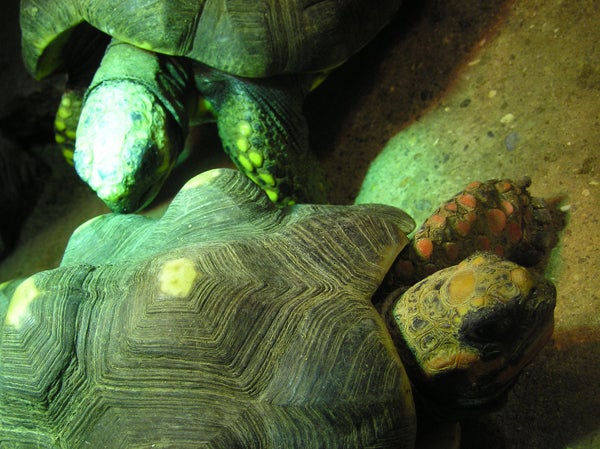
Tortoises - these are South American Chelonoidis species - are among the most familiar yet anatomically modified of turtles. The majority of turtle lineages are and were aquatic and amphibious but separate terrestrial invasions occurred on several occasions. Credit: Darren Naish
Who’s on the stem, who’s in the crown? If you know anything about the geological history of turtles, you’ll be aware that a few anatomically archaic Late Triassic and Early Jurassic turtles have been regarded as the oldest representatives of Cryptodira and Pleurodira, the two great turtle groups that exist today. Most notable among these are the Late Triassic Proterochersis (originally described as the oldest known pleurodire) and the Early Jurassic Kayentachelys (originally described as the oldest cryptodire). A Late Triassic pleurodire would mean that the common ancestor of crown turtles was in existence by this time.
On supporting science journalism
If you're enjoying this article, consider supporting our award-winning journalism by subscribing. By purchasing a subscription you are helping to ensure the future of impactful stories about the discoveries and ideas shaping our world today.
But this has been challenged. In a study devoted to phylogenetic analysis of Mesozoic turtles, Joyce (2007) argued that these early turtles are outside the crown group (crown group = the clade that contains living species and all descendants of their most recent common ancestor), and that crown turtles did not, in fact, evolve until considerably later (the Late Jurassic). Joyce (2007) and, later, other authors (Sterli et al. 2013) went further, proposing that a large number of additional taxa – among them the remarkable meiolaniids of the Cretaceous and Cenozoic, the fabled Kallokibotion of the Late Cretaceous of Romania and the diverse and abundant baenids of the Cretaceous and Paleogene – were stem-turtles too, not archaic cryptodires as long thought. This reallocation of taxa and revised view of turtle history has been accepted by some turtle specialists but not by others, and these two schools of thought currently appear to be at an impasse.
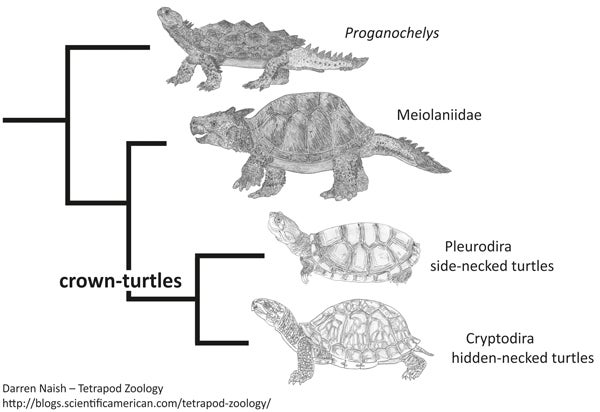
A substantially simplified phylogeny for turtles - based on the topology published by Joyce (2007) - showing meiolaniids outside the crown. Credit: Darren Naish
You might be thinking that none of this matters much, and perhaps you’d be right. But the proposal that those archaic turtle lineages are outside the crown has some important implications: meiolaniids, you see, persisted to relatively recent times, their youngest geological occurrence being from the Holocene of Vanuatu where they’ve been dated to just c 3000 years ago. We only just missed them, and by ‘missed them’ I mean that ancient members of our species hunted them to extinction. Had they persisted to the present, we would – according to the model proposed by Joyce – have especially archaic, early-diverging turtles still with us today, members of a lineage that originated far earlier in the Mesozoic than the other turtle lineages still present. A complication here is that – if meiolaniids were still alive – our definition of ‘the turtle crown’ would be far more inclusive, since all or virtually all of those lineages outside the cryptodire-pleurodire clade would now be inside the crown.
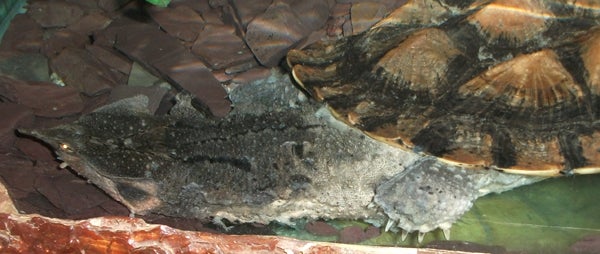
The South American matamatas (Chelus) are not exactly typical side-necked turtles, but they’re certainly among the most memorable. There is a lot of stuff about matamatas in the Tet Zoo archives (see the links below). Credit: Darren Naish
Side-necked turtles once lived just about everywhere. Today, pleurodires – the side-necked turtles – are ‘southern’ animals of Africa, Madagascar, South America and Australasia. But the fossil record shows that this is absolutely not reflective of their distribution in the past: they were effectively cosmopolitan, with species across North America, Europe and Asia. Most of these animals belonged to groups that are now wholly extinct, like the bothremydids: these were around from the Late Cretaceous until either the Oligocene or Miocene (Lapparent de Broin & Werner 1998, Gaffney et al. 2006). But others belonged to groups that now have a more restricted distribution: Neochelys – known from around 8 species that inhabited Europe during the Eocene – is a member of Podocnemididae, a group only present today in South America and Madagascar.
Archelon is not the biggest turtle. It has often been said, or at best implied, that certain of the Late Cretaceous marine protostegids – in particular the famous Archelon (“Archelon! Archelon!”, quoth Raquel Welch, 1966) – were the biggest turtles ever. This hasn’t been true for a while, even though those particular turtles sure were big. Nope, the biggest turtles of all are pleurodires, the record-holder being Stupendemys of the Upper Miocene and Pliocene of northern South America. This giant reached 3.3 m in carapace length and thus must have exceeded 5 m in total length. Incidentally, if you’ve been to the AMNH in New York and seen the Stupendemys on display there, note that its skull is not actually that of Stupendemys, it’s an enlarged replica of the skull of another sort of pleurodire: the very deep-faced Miocene podocnemidid Caninemys, named on account of its bulldog-like appearance (Meylan et al. 2009).
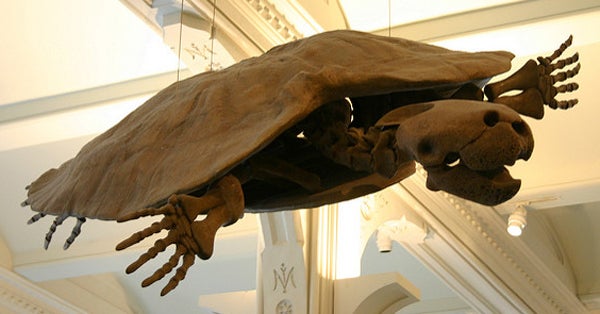
Stupendemys as on display at the AMNH in New York; the skull is that of Caninemys. Credit: Ryan Somma Flickr (CC BY-SA 3.0)
Giant tortoises were formerly widespread, and not just on islands. Today we associate giant tortoises with oceanic islands, most famously the Galápagos but also the Seychelles. If you’re up to speed on recently extinct animals you’ll also be aware of the recently extinct Cylindraspis tortoises of the Mascarenes, and perhaps of the big tortoises that also once occurred on the Caribbean islands. The impression you get from these animals is that giant size in tortoises was an island thing, and that tortoises are only able to achieve giant size when evolving in isolation from continental predators. But the fossil record paints a different picture.
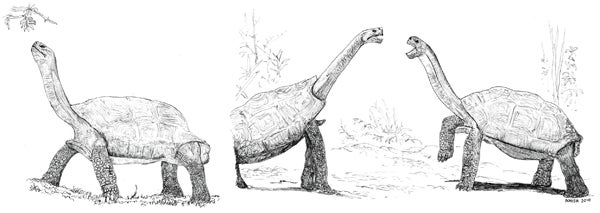
Giant tortoises - these drawings show various of the Galápagos taxa - are just amazing. Carapace length can be 1.5 m in the biggest forms; such animals can exceed 400 kg. Credit: Darren Naish
Giant tortoises – those with a carapace length exceeding 70 cm – were a widespread presence in continental habitats too, and in fact have been since the Oligocene at least. Taraschelon – an Oligocene form from France – reached c 80 cm in carapace length. The biggest tortoise of all – Megalochelys atlas (carapace length 2.1 m, mass c 1000 kg) – inhabited southern Asia between the Miocene and Pleistocene and lived alongside a typical assortment of big continental mammals, and similarly big tortoises (they may be additional specimens of Megalochelys) also inhabited eastern Europe during the Pliocene (Boev 2008). Another giant – Cheirogaster – was present in Greece during the Miocene, Pliocene and Pleistocene. Some Cheirogaster specimens exceed 1.5 m in carapace length; the skull alone can be 23 cm long. Europe was also home to several species of Titanochelon during the Miocene and Pliocene: this animal occurred from Portugal all the way to western Asia and seems to have had a carapace length of about 1.2 m. North America was home to Hesperotestudo during the Pleistocene, some species of which rivalled Galápagos giant tortoises in size. This brief listing is far from complete, but you get the point: there were really big, fully terrestrial tortoises in many continental environments during the Cenozoic.
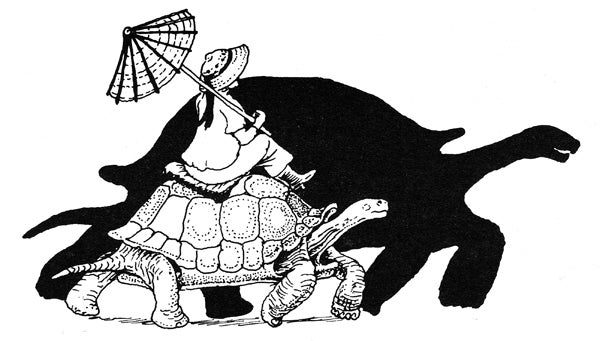
Megalochelys atlas (long known by its junior synonym Colossochelys) features in numerous popular books on prehistoric animals. This neat image - showing it to scale with a big Galápagos tortoise and human rider - is from Bakker’s The Dinosaur Heresies. M. atlas is said in some sources to have weighed 3 or 4 tons... or tonnes, which is surely not realistic for an animal of this size (it was certainly far less, as in: less than 1000 kg). Credit: Bakker 1986
It’s also worth noting that giant continental tortoises still exist today: there are some big South American Chelonoidis species, and the very large Centrochelys and Stigmochelys species of Africa. Another assumption – that these animals were limited to tropical, frost-free places – is also challenged by the fossil record, since some of these very large tortoises (thinking here of the North American Hesperotestudo) appear to have been able to dig deep burrows and avoid the cold surface temperatures sometimes present in the places where they occurred (thanks to Mark Gelbart for this idea).
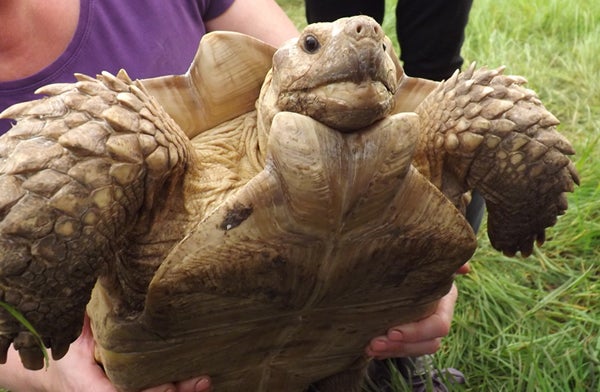
There are pretty big tortoises in continental environments even today. This is a captive African spurred tortoise (Centrochelys sulcata), the biggest specimens of which can have a carapace length of over 80 cm. Credit: Darren Naish
That will do for now. We will revisit turtles again soon. While on the subject of this group, my review of Olivier Rieppel new book Turtles As Hopeful Monsters has recently been published (Naish 2017). For previous Tet Zoo turtle articles, see…
Gilbert White's pet tortoise, and what is 'grey literature' anyway?
The familiar Matamata, known to us all since the 1700s, and its long, fat neck (matamatas part II)
"Adaptation perfected" (possibly) in a turtle's head (matamatas part III)
Necks for sex? No thank you, we're sauropod dinosaurs (includes brief discussion of Galapagos tortoises)
Turtles that eat bone, rocks and soil, and turtles that mine
Refs - -
Bakker, R. T. 1986. The Dinosaur Heresies. Penguin Books, London.
Boev, Z. 2008. First finds of giant land tortoises discovered in Bulgaria. Science News April 2008, 2-4.
Gaffney, E. S., Tong, H. & Meylan, P. A. 2006. Evolution of the side-necked turtles: the families Bothremydidae, Euraxemydidae, and Araripemydidae. Bulletin of the American Museum of Natural History 300, 1-700.
Joyce, W. G. 2007. Phylogenetic relationships of Mesozoic turtles. Bulletin of the Peabody Museum of Natural History 48, 3-102.
Lapparent de Broin, F. de & Werner, C. 1998. New late Cretaceous turtles from the Western Desert, Egypt. Annales de Paléontologie 84, 131-214.
Meylan, P. A., Gaffney, E. S. & Campos, D. de A. 2009. Caninemys, a new side-necked turtle (Pelomedusoides: Podocnemididae) from the Miocene of Brazil. American Museum Novitates 3639, 1-26.
Sterli, J., de la Fuente, M. & Cerda, I. A. 2013. A new species of meiolaniform turtle and a revision of the Late Cretaceous Meiolaniformes of South America. Ameghiniana 50, 240-256.